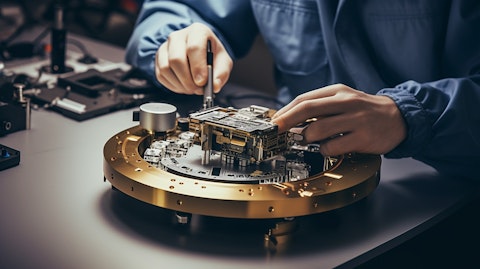Sidus Space, Inc. (NASDAQ:SIDU) Q4 2023 Earnings Call Transcript March 27, 2024
Sidus Space, Inc. isn’t one of the 30 most popular stocks among hedge funds at the end of the third quarter (see the details here).
Operator: Greetings, and welcome to the Sidus Space Fourth Quarter and Full Year 2023 Results Conference Call. At this time, all participants are in a listen-only mode. As a reminder, this conference is being recorded. It is now my pleasure to introduce your host, Valter Pinto, Managing Director, KCSA. You may begin. Please proceed.
Valter Pinto: Good morning, everyone. And thank you for joining us for the Sidus Space fourth quarter and full year 2023 financial results conference call. Joining us today from the company is Carol Craig, Founder and Chief Executive Officer; and Bill White, Chief Financial Officer. During today’s call, we may make forward-looking statements. These statements are based on current expectations and assumptions, and as a result, are subject to risks and uncertainties. Many factors could cause actual results to differ materially from the forward-looking statements made on this call. These factors include our ability to estimate operational expenses and liquidity needs, customer demand, supply chain delays, including launch providers and extended sales cycles.

For more information about these risks and uncertainties, please refer to the risk factors in the company’s filings with the Securities and Exchange Commission, each of which can be found on our Web site, www.sidusspace.com. Listeners are cautioned not to put any undue reliance on forward-looking statements. And the company specifically disclaims any obligation to update the forward-looking statements that may be discussed during this call. At the conclusion of our prepared remarks, we’ll be answering questions submitted in advance. If we do not get to your question within the time frame allotted for this morning’s call, please email our team at sidus@kcsa.com. At this time, I would like to turn the call over to Carol. Carol, please go ahead.
Carol Craig: Thank you, Valter. And welcome, everyone. 2023 was a pivotal year for Sidus as we worked toward the launch of LizzieSat. Earlier this month, we successfully deployed from the SpaceX Transporter-10 Rideshare Mission followed by successful establishment of communications and retrieval of health and status data. LizzieSat-1 is the first of several satellites planned for launch to low earth orbit. We are quickly building our multi mission constellation of 3D printed AI enhanced satellites with two more LizzieSat manifested for launch with SpaceX before the end of this year. The steps we took to prepare since our IPO and through 2023 led us to the successful deployment of LizzieSat-1. The steps we took were both technical and organizational.
We built a foundation for the future that included investment in people, processes and technology. We focused on critical areas that contributed to the success of our initial launch and deployment and at the same time to our strategic plan for the next several years. This includes development of simulation, guidance and navigation and flight software, and combined with our hardware innovations establishes a new line of products with flight heritage and experience. Integrating established design and processes related to environmental testing, redundancy of systems and agile development resulted in not only success right out of the gate the first time but also a rapid development capability that will allow us to grow and evolve as the space ecosystem grows and evolves.
See also 11 Crypto Stocks with Biggest Upside and 20 Best Airlines in the World in 2024.
Q&A Session
Follow Sidus Space Inc.
Follow Sidus Space Inc.
We streamlined and matured our leadership team and our Board of Directors with a focus on the long term outlook. This means bringing in leadership with the ability to connect, flex and grow as we look to capture more of both government and commercial markets benefiting from LEO, the Moon and Mars programs. 2023 also brought significant upgrades to our LizzieSat, including the addition of an artificial intelligence edge computing solution. This is made possible through the acquisition of Exo-Space in the third quarter of 2023. This acquisition allowed us to add the FeatherEdge AI hardware and software solutions to our product line and also integrate AI into our satellites, giving us a significant edge when capturing data for sale to our customers.
AI processing of data using what is called edge computing reduces the time between data collection and decision making, which is critical to time sensitive applications, such as autonomous systems and even remote sensing applications. Outfitting our satellite to function as an edge device with local compute unlocks a host of operational benefits, including reduced transmission time, greater security and lower transmission costs. Specifically, the two key areas that benefit from AI are on satellite data storage and transmission of data back to earth. Our FeatherEdge AI solves both of these potential issues. The proprietary FeatherEdge AI hardware enclosure allows us to continue to rapidly upgrade our memory and processors on future LizzieSats, allowing us to remain state-of-the-art as computer hardware continuously progresses.
The FeatherEdge AI software is capable of being updated on orbit as well, which allows our customers to rapidly adapt to changing markets and mission requirements. And additionally, this proprietary software solution uses onboard machine learning to parse out the data that’s most valuable to our customers. This dramatically increases the quality of the data that we download to ground stations. So essentially, instead of incurring the delay and cost of moving large volumes of raw data back to earth, the processing can be moved into space, including to the point where actionable insight can be delivered directly to the end user without that raw data even touching earth. While we’re extremely proud of our recent successes, it’s important not to forget that space is a very difficult environment.
Space is hard and executing the right way takes time and experience. Our decade plus of manufacturing space hardware is one of the reasons our first satellite is in the satellite catalog right now. It’s important to note that this would not have been possible without the successful coloration with other companies and government agencies during and after the launch. After deploying from the Falcon 9 rocket, we worked with other Transporter-10 riders to share location information and confirm the orbit state of LizzieSat. We saw the space community come together to sort and correlate these tracks for our closely spaced group of vehicles, which is common for rideshare deployments into low earth orbit. And we’re truly grateful for this information sharing and the spirit of collaboration with our peers in the space industry.
Not only the design, build and test of a satellite very complex but the follow on stages, including launch in early orbit, commissioning phase and mission preparation are all very complicated endeavors. After the successful launch and deployment of our first LizzieSat, we’re excited to report that we have achieved the critical milestones related to understanding the health and status of our operational satellites. Now that LizzieSat is in orbit, circling the earth approximately every 95 minutes and providing two way communication, we’re looking forward to focusing on data collection, onboard processing and filtering, download of data and sales. We’re currently in the commissioning stage, which includes sequential activation and checkout of the spacecraft subsystems, the calibration of payloads, sensors and control systems, which we think will take between 60 to 90 days.
Following this, we expect to have the first sensor data and images collected with revenue realized from LizzieSat in later months of this year. Additionally, the heritage of building, launching and operating a commercial satellite of our size greater than 100 kilogram puts Sidus Space in a very small group of companies with the ability to pursue more advanced and long term opportunities with both government and commercial entities. Even though we are successfully operating LizzieSat-1, the experience has resulted in both technical and cost efficiencies that will support our economies of scale and cost reductions in the next few years. As we continue with production for our next few satellites, including the two manifested for the end of this year, we’re able to integrate the improvements that we identified as a result of the success of our first LizzieSat.
We’ve become an even more efficient operating unit going forward and we anticipate expanding as an organization with new technologies and new markets. One of the reasons that we can so quickly adapt and integrate recognized solutions and lessons learned is because at Sidus we practice smart vertical integration. We manufacture our own bus and we use selected space proven subcomponents, which allow us to select the best technology to suit the mission objective. LizzieSat-1 is a full production satellite, not just a proof of concept. This is all part of our plan to establish a steady production cadence of our satellites. While most other companies our size have had a gap between their first mission and subsequent missions, LS-2 and LS-3 are in full production and currently on schedule for their manifested launch in Q4 this year.

